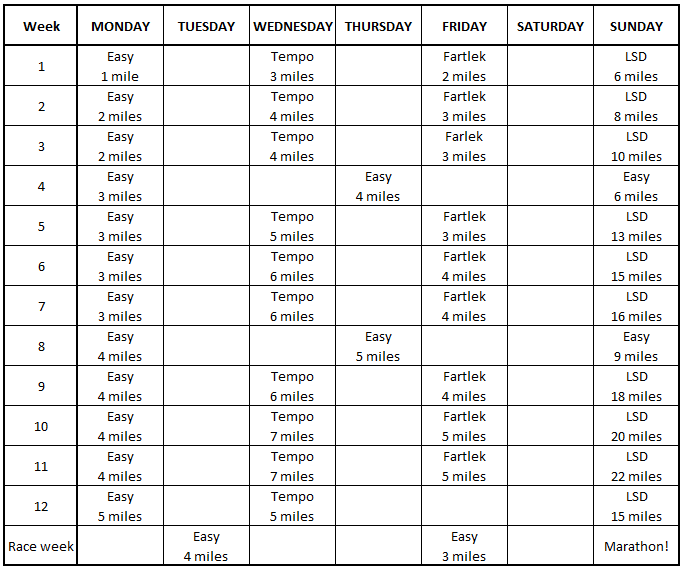Running a marathon is very doable. I’m going to teach you how to train for a marathon so you can get it done in just three months. A marathon is 26.2 miles and, depending on the race, you can expect runners to finish anywhere in between two and six hours.
There are a few things to keep in mind.
Running 26.2 miles is a long way. It is very demanding on your muscles, tendons, ligaments, bones, cardiovascular fitness, and is just as demanding on your mental stamina. At any one time, 50% of all runners are injured. They have shin splints, plantar fasciitis, stress fractures and unexplained niggles. Do see your doctor for a check-up before engaging in any strenuous activity. If you experience any soreness other than general fatigue, you must see a professional right away for a quick fix–-better to miss a day of training while the injury is easily repairable than to a miss a month of training because you thought it would go away.
One more warning:
Running is addictive. Once you finish your marathon, you will not be the same person you were when you started training. You will be stronger in your body and in your mind. You will know that sense of freedom unique to runners. You will salute others in your neighborhood with that grin known to all runners. And you will become a better person. If you have the guts to commit to a marathon, you should start by familiarizing yourself with running terminology. Long Steady Distance (or LSD) – This is your most important run of the week. You will go at a steady reasonable pace for a longer distance than your other runs. This run builds up your endurance stamina. Beginner’s tip: Include regular walk breaks. Tempo – This run is the medium distance run in your week, and is done a little faster than your LSD. This run will improve your lactic threshold, which is that burn you get in your legs when you are pushing it. Beginner’s tip: Push the pace, but don’t go totally flat out. Fartlek – This hilariously named run is Swedish for speed play. In this run you will alternate between fast and slow running. Over time, this will help increase the speed of all your other runs. Beginner’s tip: Alternate between running as fast as you can and walking. Use lamp posts or street corners to decide when to walk or run. Easy – Just like it sounds, this run is shorter, slower and more relaxed than the others. Its purpose is to keep your legs ticking over to add a few extra miles in your week, without putting additional stress on your muscles and bones. Beginner’s tip: Always run this slower than your natural run pace. If your pace is very slow, make this a walk. Rest – Rest is the most neglected part of training. Rest is doing nothing, sleeping, eating, hydrating, getting a massage, and chilling out after the previous strenuous weeks. Rest is when your muscles and bones strengthen, your immune system rejuvenates, and your body prepares itself for your next session. Do not skip this! Those terms are really all you need to know to complete a marathon. Once you’ve picked your race, you can start training. Each run needs to be done once each week. Every 4 weeks, you’ll take a recovery week where you’ll only do Easy runs. Most people do their LSD on the weekend when they have more time. Simply pick which day of the week suits you best and stick to that. Your Easy run will best fit either the day before or the day after your LSD. Your Tempo and Fartlek will fit in whichever other days work best for you. Here’s an example of how this might fit into your week:
Now you’ll need to build your plan–in this case three months (or 13 weeks)–until Race Day. It is best to plan it all out now, rather than doing it on a weekly basis.
Fill in your LSD run distances first. These will build up gradually over time. Build in your recovery weeks approximately every 4th week. Add in your Easy runs. Add in your Tempo and Fartlek runs. The 7-10 days before the marathon you’ll need to taper your training.
Here’s a sample for you:
Tips:
If you have already been running for a while, you can skip the first 4 weeks of this plan and knock it off sooner! Many runners have GPS watches. They are great to help you keep track of your distance and pace. If you don’t want to fork out for a specialist watch, there are many free apps available to download on your smartphone. Depending how long the marathon will take you, you may need to learn how to eat food on the go. Glucose gels are the most convenient source of energy. You can also experiment with energy bars or by adding honey to your drink. Carrying a drink bottle for more than a few miles is very annoying. There are plenty of waist packs, hands-free bottles, and hydration backpacks available so you don’t need to carry a bottle. For your first marathon, time isn’t important. The important thing is that you did enough training to complete it. If you feel rubbish on the day, or the weather is crazy, that’s okay. Take it easy, chat to other runners, and soak up the atmosphere.
When the going gets tough, dig deep and remember you are one of us now. You are a runner. Best of luck! Featured photo credit: Army 10-Miler – 2010 – AUSA – FMWRC – United States Army – 101024 / photo by familymwr via fotopedia.com

